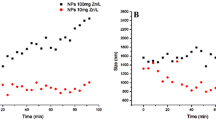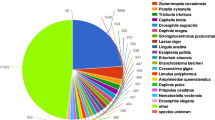Abstract
A preparation of niclosamide named 50 % wettable powder of niclosamide ethanolamine salt (WPN), the only chemical molluscicide available in China, has been widely used for Oncomelania hupensis control over the past 20 years, but its molluscicidal mechanism has not been elucidated yet. Recently, a derivative of niclosamide, the salt of quinoid-2',5-dichloro-4'-nitro-salicylanilide (Liu Dai Shui Yang An, LDS), has been proven to have equivalent molluscicidal effects as WPN but with lower cost and significantly lower toxicity to fish than WPN. In our previous study, gene expression profiling of O. hupensis showed significantly effects after these two molluscicides had been applied. This study was designed to use morphological and enzymological analyses to further elucidate the mechanism by which these molluscicides cause snail death. After WPN or LDS treatment, the number of mitochondria of O. hupensis was reduced and their cristae appeared unclear, heterochromatin gathered to be polarized, ribosome numbers of the rough endoplasmic reticulums (rERs) decreased, myofilaments in muscle cells became disordered and loose, and cytoplasm in some liver cells was concentrated. Damage of cell structures and organelles suggested inhibited movement ability and effects on liver and energy metabolism following treatment. In parallel, activities of enzymes related with carbohydrate metabolism were inhibited except lactate dehydrogenase (LDH) increased in muscle tissue, and activities of enzymes related with stress response increased followed by decreasing to lower levels than those of the H2O-treated group. This shift of carbohydrate metabolism patterns led to insufficient energy supply and lactic acid accumulation, and variations of nitric oxide synthase (NOS), alanine aminotransferase (ALT), and superoxide dismutase (SOD) during process of molluscicide treatment suggested a stress response of snail to the molluscicides at early stages and later fatal damage in liver and nervous system. In general, effects of WPN and LDS were similar although LDS-treated snails showed more serious damage in the liver and a stronger inhibition of enzymes related with aerobic respiration and stress response. This was consistent with the transcriptome profile obtained previously. However, considering enzyme activities at post-transcriptional and protein levels, comprehensive identification and annotation of potential enzyme-related genes and regulation pattern would be necessary to provide great benefit for understanding of potential mechanism of these molluscicides and even for future molluscicide development.






Similar content being viewed by others
References
Dai JR, Liang YS, Wang R, Xiong XK, Zhang YP, Wang PH, Zhang Y, Hang PY, Huang YX, Zhu YC (2001) Study on synergic molluscicidal mechanism of niclosamide mixed with B002 against Oncomelania. Chin J Parasit Dis Con 14(1):11–13
Dai JR, Zhu YC, Liang YS, Li HJ, Gong MT, Zhang JS, Guan XH (2006) Development of a novel synergism compound suspension concentrate of niclosamide and chlorphoxim. Chin J Schisto Control 17(6):413–416
Dai JR, Wang W, Liang YS, Li HJ, Guan MT, Zhu YC (2008) A novel molluscicidal formulation of niclosamide. Parasitol Res 103:405–412. doi:10.1007/s00436-008-0988-2
Dai JR, Li YZ, Wang W, Xing YT, Qu GL, Liang YS (2014) Resistance to niclosamide in Oncomelania hupensis, the intermediate host of Schistosoma japonicum: should we be worried? Parasitology 8:1–9. doi:10.1017/S0031182014000870
Dong H, Wang YG, Zhao QP, Han HY, Zhu SH, Li LJ, Wu YL, Huang B (2014) Molecular cloning and characterization of lactate dehydrogenase gene from Eimeria tenella. Parasitol Res 113(8):2915–2923. doi:10.1007/s00436-014-3953-2
Han S, Xiong XH, Wang JH, You S, Zhang WC (2011) Fusion expression and purification of cytochrome c oxidase subunit II of Ketogulonigenium vulgre. Lett Biotechnol 22(6):814–817
Hang PY, Dai JR, Liang YS, Wang R (2001) Study on influence of B002 and niclosamide to nitric oxide synthase in Oncomelania snail. Chin J Schisto Control 13(5):278–279
Henriquez FL, McBride J, Campbell SJ, Romos T, Ingram PR, Roberts F, Tinney S, Roberts CW (2009) Acanthamoeba alternative oxidase genes: identification, characterisation and potential as antimicrobial targets. Int J Parasitol 39(13):1417–1424. doi:10.1016/j.ijpara.2009.04.011
Huang YX (2013) Wetland protection and Oncomelania hupensis control. Chin J Schisto Control 25(5):533–537
Ke WS, Yang JL, Xiong ZT (2006) The toxicity effect of Arisaema erubescens Schott on Oncomelania hupensis. Asian J Ecotoxicol 1(3):283–288
Khawsak P, Kanjanavas P, Kiatsomchai P, Chansiri K (2012) Expression and characterization of Cu/Zn superoxide dismutase from Wuchereria bancrofti. Parasitol Res 110(2):629–636. doi:10.1007/s00436-011-2532-z
Kumar P, Singh VK, Singh DK (2009) Kinetics of enzyme inhibition by active molluscicidal agents ferulic acid, umbelliferone, eugenol and limonene in the nervous tissue of snail Lymnaea acuminata. Phytother Res 23(2):172–177. doi:10.1002/ptr.2578
Li WG, Tang C (1994) Ultrastructural change of brain ganglion of Oncomelania hupensis after immersion in sodium pentachlorophenate. Chin J Parasitol Parasit Dis 12(2):125–128
Li WG, Huang SX, Xu MX, Wang YM, Hu LL, Gao ZQ, Cheng ZY, Wang Y, Zhou HL, Zhan ZW, Tang C (1997) Ultrastructural changes of cerebral ganglion of Oncomelania hupensis after immersion in niclosamide. Chin J Parasit Con 10(1):42–45
Li HJ, Liang YS, Dai JR, Xu M, Ru YY, Xu YL (2006) Enzyme-histochemical observation on influence of suspension concentrate of niclosamide in Oncomelania hupensis snails. Chin J Schisto Control 18(6):427–430
Liu ZH (2000) Pathological staining technique. People’s Medical Publishing House, Beijing
Liu GY, Li WG, Wang YM, Tang C (1998) Ultrastructural changes of liver of Oncomelania hupensis after immersion in niclosamide. Chin J Zoonoses 14(6):46–48
Liu R, Dong HF, Jiang MS (2013) The new national integrated strategy emphasizing infection sources control for schistosomiasis control in China has made remarkable achievements. Parasitol Res 112:1483–1491. doi:10.1007/s00436-013-3295-5
Lv Y, Wang XS, Li WX, Zhu J, Liu S (2010) Effect of Nic and SX-I exposure on the soluble protein on the Oncomelania hupensis. Agrochemicals 49(12):882–884
Mcgullough FS, Gayral P, Duncan J, Christie JD (1980) Molluscicides in schistosomiasis control. Bull WHO 58(5):681–689
Medeiros ID, Siebert MN, de Toledo e Silva G, Moraes MO, Marques MR, Bainy AC (2008) Differential gene expression in oyster exposed to sewage. Mar Environ Res 66(1):156–157. doi:10.1016/j.marenvres.2008.02.048
MOH (2000) Handbook of schistosomiasis control (Ministry of Health), 3rd edn. Shanghai Science and Technology Literature Publishing House, Shanghai, pp 204–208
Song GM, Wang GF, Ma JQ, Yang JY (1997) Effect of seed of Camellia sinensis on the hepatopancreas and genital system of Oncomelania hupensis. Chin J Parasitol Parasit Dis 3:170–173
Tan P, Yang JM, Guan Y, Liu B, Ke WS (2006a) Effect of Alternanthera philoxeroides on the ultrastructure of the ganglion and foot muscle of Oncomelania hupensis. J Chin Electr Microsc Soc 25(6):524–527
Tiwari S, Singh A (2005) Alterations in carbohydrates and the protein metabolism of he harmful freshwater vector snail Lymnaea acuminata induced by the Euphorbia tirucalli latex extract. Environ Res 99(3):378–386
Vanlerberghe GC, McIntosh L (1996) Signals regulating the expression of the nuclear gene encoding alternative oxidase mitochondria. Plant Physiol 111(2):589–595
Vanlerberghe GC, McIntosh L (1997) Alternative oxidase: from gene to function. Plant Mol Biol 48:703–734
Wang XS, Liu GY, Lv Y, Li WX, Wang Q (2009) Optimal catalytic conditions of glutamic-oxalacetic transaminase from Oncomelania hupensis and its sensitivity to niclosamide. Agrochemicals 48(11):797–799
WHO (1985) The control of schistosomiasis: report of a WHO expert committee. World Health Organ Tech Rep Ser 728:58–61
WHO (1993) The control of schistosomiasis: second report of the WHO expert committee. World Health Organ Tech Rep Ser 830:51–53
WHO Expert Committee (2002) Prevention and control of schistosomiasis and soil-transmitted helminthiasis. World Health Organ Tech Rep Ser 912:7–17
Wu XY, Yang LQ, Zhang LH, Ge QJ (2006) Progress of research on molluscicides. Chin J Schisto Control 18(6):474–476
Xia QB, Tan PP, Peng LX, Zhang SA (2001) Observation on liver of Oncomelania snails under optical and electron microscope. Acta Zool Sin 47(1):19–26
Xia J, Yuan Y, Xu XJ, Wei FH, Li GL, Liu M, Li JQ, Chen RJ, Zhou ZP, Nie SF (2014) Evaluating the effect of a novel molluscicide in the endemic Schistosomiasis japonica area of China. Int J Environ Res Public Health 11:10406–10418. doi:10.3390/ijerph111010406
Yang JS, Zhou SL, Tang XN, Chen WK (2007) Influence of niclosamide on phenol oxidase activity in Oncomelania snails. Chin J Schisto Control 19(4):311–312
Yuan Y, Xu XJ, Dong HF, Jiang MS, Zhu HG (2005) Transmission control of Schistosomiasis japonica: implementation and evaluation of different snail control interventions. Acta Trop 96(2-3):191–197
Yuan Y, Dong HF, Xu XJ, Li GL, Wei FH, Zhao YB, Tu ZW, Liu M, Cao MM, He H, Tang L, Zhu H, Fan HP (2011) Evaluation of a new molluscicide for counteracting the intermediate snail host of Schistosoma japonicum. Malacologia 53(2):217–227
Zhai ZH, Wang XZ, Ding MX (2000) Cell biology. Higher Education Press, Beijing
Zhang CS, Zhang Q, Shi MZ, He HB, Li GP, Peng LX (2002) Electron microscopy observations on effects of Chazhaosu to liver and reproductive glands of Oncomelania hupensis. Chin J Schisto Control 14(6):453–454
Zhao QP, Xiong T, Xu XJ, Jiang MS, Dong HF (2015) De novo transcriptome analysis of Oncomelania hupensis after molluscicide treatment by next-generation sequencing: implications for biology and future snail interventions. Plos One 10(3):e0118673. doi:10.1371/journal.pone.0118673
Zheng T, Shi QQ, Wu SG (2002) Purification and properties of fumarase from Aspergillus wentii. Microbiol China 29(1):30–34
Zhong CS (1989) Techniques for enzyme cytochemistry. Shanghai Medical University Press, Shanghai
Zhou XL, Zhang Y, Hong QB, Xu JD, Wang TP (2005) Science on Oncomelania snail. Science Press, Beijing
Zhu D, Li HJ, Liu HX, Zhang Y, Guo J, Liang YS, Zhou SN (2007) Enzyme histochemistry: the effect of META-Li on Oncomelania hupensis. Chin J Parasitol Parasit Dis 25(3):198–201
Zickermann V, Wittershagen A, Kolbesen BO, Ludwig B (1997) Transformation of the CuA redox site in cytochrome c oxidase into a mononuclear copper center. Biochemistry 36(11):3232–3236
Acknowledgments
Our most heartfelt thanks are due to Mr. Xiong Liu and his group at the Institute of Schistosomiasis Control of Jianglin County, Hubei Province, China, for their assistance in collecting O. hupensis in the field. Dr. Christoph G. Grevelding in Institute for Parasitology, Justus-Liebig-University GieBen give us valuable comments which have significantly improved the manuscript. This work was supported by the National Science and Technology Major Project of China (No. 2012ZX0004-909) and Major Project of Health and Family Planning Commission of Hubei Province (No. XF2012-3).
Author information
Authors and Affiliations
Corresponding authors
Additional information
These two authors equally contributed to this work and should be considered as the co-first authors.
Rights and permissions
About this article
Cite this article
Xiong, T., Zhao, Q.P., Xu, X.J. et al. Morphological and enzymatical observations in Oncomelania hupensis after molluscicide treatment: implication for future molluscicide development. Parasitol Res 115, 4139–4152 (2016). https://doi.org/10.1007/s00436-016-5188-x
Received:
Accepted:
Published:
Issue Date:
DOI: https://doi.org/10.1007/s00436-016-5188-x




